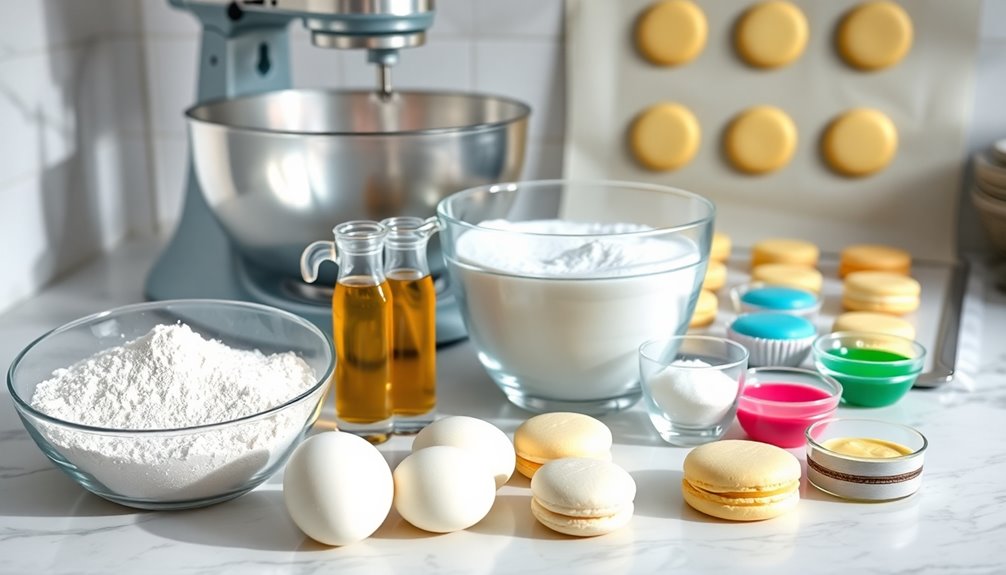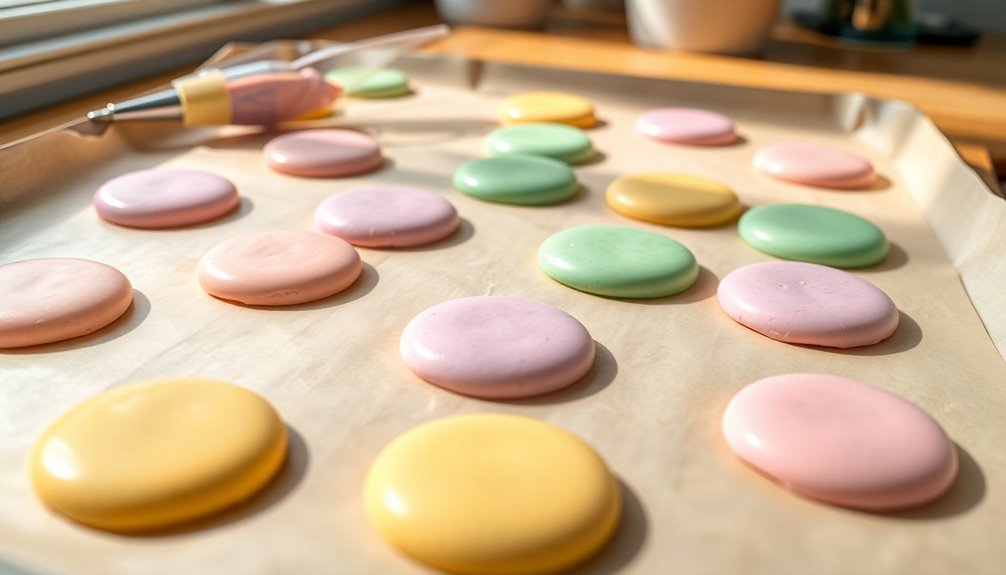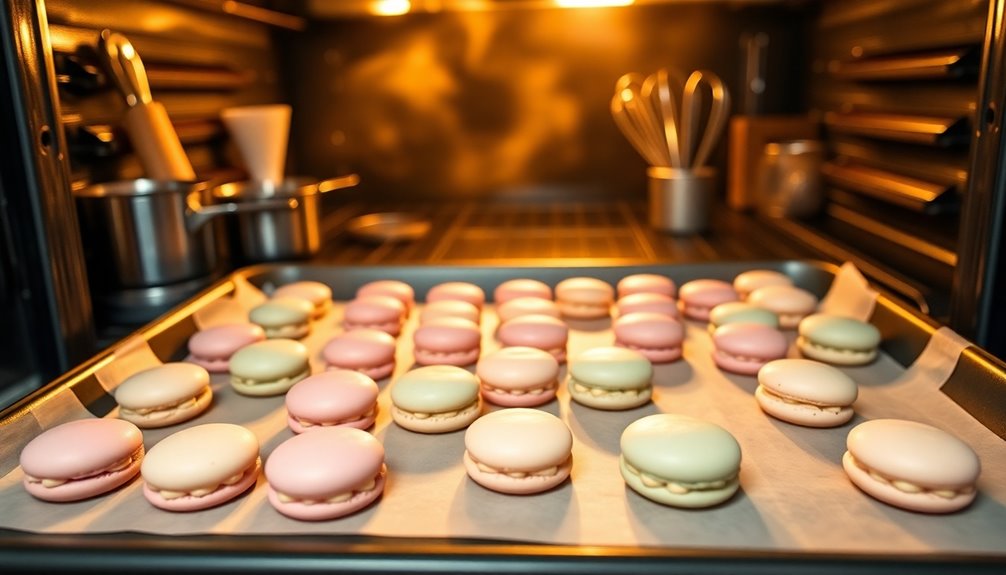To make delightful macarons, you'll need 1 ¾ cups almond flour, 2 cups powdered sugar, 4 large egg whites, and ½ cup granulated sugar. Start by sifting the almond flour and powdered sugar together. Whip the egg whites to soft peaks, add granulated sugar, and whip until stiff. Gently fold the dry ingredients into the meringue, then pipe circles on a parchment-lined sheet. Let them rest for 30 minutes, then bake at 300°F for 12-20 minutes. Cool before removing. With a few simple steps and some tips, you can master these treats and explore exciting flavor variations too!
Key Takeaways
- Combine 1 ¾ cups almond flour and 2 cups powdered sugar, sifting together for a fine texture before mixing.
- Whip 4 large egg whites to stiff peaks after gradually adding ½ cup granulated sugar for stability.
- Gently fold the dry mixture into the meringue, ensuring to maintain airiness for the macaron structure.
- Pipe the batter into uniform circles on a parchment-lined baking sheet, then let rest for 30 minutes before baking.
- Bake at 300°F (150°C) for 12-20 minutes, monitoring closely to avoid over-baking and achieve the desired texture.
History

The history of macarons is as rich and colorful as the treats themselves. You might be surprised to learn that these delicate cookies originated in Italy during the Renaissance.
They eventually made their way to France, where they evolved into the delightful confections we recognize today. The French refined the recipe, adding almond flour and sugar, which gave them their signature texture.
Initially, macarons were simple, but over time, they became filled with a variety of creams and ganaches, taking on vibrant colors and flavors.
By the 20th century, macarons had gained immense popularity, especially in Paris, where they became a staple of patisserie culture.
This history reflects the journey of a treat that's both sophisticated and adored worldwide.
Recipe

Macarons are delicate French confections known for their crisp exterior and soft, chewy interior. These delightful treats are made from a simple mixture of almond flour, sugar, and egg whites, but achieving the perfect macaron can be quite the art. With a little patience and practice, you can create these colorful cookies filled with various delicious fillings like buttercream, ganache, or jam. They're perfect for any occasion, whether it's a fancy tea party, a birthday celebration, or simply a sweet treat to enjoy at home.
To get started, gather your ingredients and prepare your workspace. It's crucial to use high-quality almond flour and verify that your egg whites are at room temperature for the best whipping. Before beginning, make sure your mixing bowls and utensils are clean and free of any grease, as this can prevent the egg whites from whipping properly.
Once you're ready, you'll be on your way to impressing friends and family with your homemade macarons.
Ingredients:
- 1 ¾ cups almond flour
- 2 cups powdered sugar
- 4 large egg whites (room temperature)
- ½ cup granulated sugar
- 1 teaspoon vanilla extract (or any other flavoring)
- Food coloring (optional)
- Filling of your choice (buttercream, ganache, or jam)
To make the macarons, start by sifting the almond flour and powdered sugar together into a bowl to remove any lumps. In a separate bowl, beat the egg whites until foamy, then gradually add the granulated sugar while continuing to beat until stiff peaks form.
Add the vanilla extract and food coloring if desired, mixing gently until combined. Carefully fold the almond flour mixture into the egg whites in three additions until fully incorporated. The batter should flow like lava and form a ribbon when lifted.
Pipe small circles onto a parchment-lined baking sheet and let them sit at room temperature for 30-60 minutes until a skin forms on the surface. Preheat your oven to 300°F (150°C) and bake the macarons for 15-20 minutes. Allow them to cool completely before filling with your favorite filling.
Extra Tips:
For the best results, use a kitchen scale to measure your ingredients accurately, as precision is key in macaron-making. Make sure to age your egg whites by letting them sit in the fridge for a day or two before use; this helps reduce moisture.
Additionally, practice makes perfect! Don't be discouraged if your first batch doesn't turn out perfectly—keep trying, and you'll soon master the technique. Store your finished macarons in an airtight container in the refrigerator for up to a week or freeze them for longer storage.
Cooking Steps

To create perfect macarons, you'll want to start by measuring the almond flour precisely.
Next, fold in the egg whites carefully to achieve the right consistency.
Once you've piped the batter into circles, let them rest for 30 minutes before baking at 300°F (150°C).
Step 1. Measure Almond Flour Precisely

Measuring almond flour precisely is essential for achieving that perfect macaron texture. Start by using a digital kitchen scale for accuracy. Scoop the almond flour directly from the bag with a spoon, then gently spoon it into your measuring cup without packing it down. Level off the top with a straight edge, like a knife, to guarantee you're not adding too much.
If you don't have a scale, use the spoon-and-level method instead. Remember, too much almond flour can lead to dense macarons, while too little might make them fragile. Aim for 100 grams or about 1 cup of almond flour, depending on your recipe, and sift it to remove any lumps before mixing.
Precision is key!
Step 2. Fold in Egg Whites

Once you've measured and sifted your almond flour, it's time to incorporate the egg whites.
Gently fold the whipped egg whites into the dry ingredients using a spatula. Start by adding a small portion of the egg whites to lighten the mixture, making it easier to combine.
Use a motion that scoops from the bottom and folds over the top, being careful not to deflate the egg whites too much. Continue this process until the mixture is smooth and shiny, resembling thick lava.
It should flow slowly off the spatula when lifted. If you overmix, your macarons may not rise properly, so keep a close eye on the consistency.
Once you achieve the right texture, you're ready for the next step.
Step 3. Pipe Batter Into Circles

With your smooth and shiny macaron batter ready, it's time to pipe it into perfect circles.
Grab a piping bag fitted with a round tip, and fill it with your batter. Hold the bag vertically above your parchment-lined baking sheet, and gently squeeze the bag to release the batter. Aim to create circles about 1.5 inches in diameter, maintaining even pressure as you pipe.
To achieve uniformity, you can use a template under the parchment. Once you've piped all your circles, lift the piping bag straight up to avoid unwanted peaks. If any peaks form, lightly tap the baking sheet on the counter to smooth them out.
Now, you're one step closer to delicious macarons!
Step 4. Rest for 30 Minutes

After piping your macaron batter into circles, let them rest for 30 minutes at room temperature. This step is essential for achieving that perfect macaron texture.
During this resting period, a skin forms on the surface of the batter, which helps create the iconic smooth top and those beautiful feet once baked. Make sure the macarons are undisturbed, as any movement can disrupt the skin formation.
If you're in a humid environment, consider using a fan to assist with drying. You'll know they're ready to bake when you can gently touch the surface without any batter sticking to your finger.
Patience is key here; don't rush this step for the best results!
Step 5. Bake at 300°F (150°C)

Now that your macarons have rested and developed a skin, preheat your oven to 300°F (150°C) to create the perfect baking environment.
Line a baking sheet with parchment paper, and gently place your macarons on it, making sure they're spaced evenly. Avoid overcrowding them, as they need room to rise.
Bake for 15 to 20 minutes, keeping an eye on them to prevent over-baking. You'll know they're done when they form a firm shell and can be lifted off the parchment easily. If they're wobbly, give them a few more minutes.
Once baked, let them cool completely on the sheet before gently removing them. This step is essential for achieving that perfect texture.
Happy baking!
Final Thoughts

As you wrap up your macaron-making adventure, it's important to reflect on the joy these delicate treats can bring.
You've embraced a fun challenge, and with practice, your skills will only improve. Each colorful macaron holds the potential for creativity, allowing you to experiment with flavors and fillings that excite your taste buds.
Remember, even if some batches don't turn out perfectly, it's all part of the learning process. Don't be discouraged; instead, savor the journey of making these delightful confections.
Share your successes with friends and family, and inspire them to join you in this sweet pursuit.
Frequently Asked Questions
Can I Use Almond Flour Substitutes for Macarons?
You can definitely use almond flour substitutes for your baking, but keep in mind that the texture and flavor might change.
Options like finely ground cashew flour or sunflower seed flour can work, but they mightn't provide the same delicate crispness.
Experimenting with these alternatives may require slight adjustments in moisture and blending times, so don't hesitate to tweak your method until you find what suits your taste best!
How Do I Store Leftover Macarons?
To store leftover macarons, you'll want to keep them in an airtight container.
Place parchment paper between layers to prevent sticking.
If you're not eating them right away, refrigerate them for up to a week.
For longer storage, freeze them in a single layer, then transfer them to a freezer-safe container.
When you're ready to enjoy, just let them thaw at room temperature for about 30 minutes.
What Is the Ideal Temperature for Making Macarons?
When you're making delicate treats, the ideal temperature is essential. Aim for a kitchen temperature between 65°F and 72°F (18°C to 22°C).
If it's too warm, your batter might become too runny, affecting the final texture. Conversely, if it's too cold, you might struggle with proper mixing.
Keeping your workspace at a consistent, moderate temperature will help guarantee your creations turn out perfectly, with that signature smooth shell and chewy interior.
Can I Freeze Macarons for Later Use?
Yes, you can definitely freeze macarons for later use!
Just make sure to place them in an airtight container or wrap them tightly in plastic wrap to prevent freezer burn.
When you're ready to enjoy them, let them thaw in the refrigerator for a few hours.
This way, they'll retain their delicious flavor and texture.
How Do I Troubleshoot Cracked Macarons?
If you're dealing with cracked surfaces, it's often due to overmixing or under-mixing your batter.
Make sure you fold the ingredients just until combined, achieving a smooth yet thick consistency.
Check your oven temperature too; it might be too high, causing the shells to rise too quickly.
Consider letting your macarons rest longer before baking, as this helps form a protective skin that can reduce cracking.
Practice makes perfect, so keep trying!










